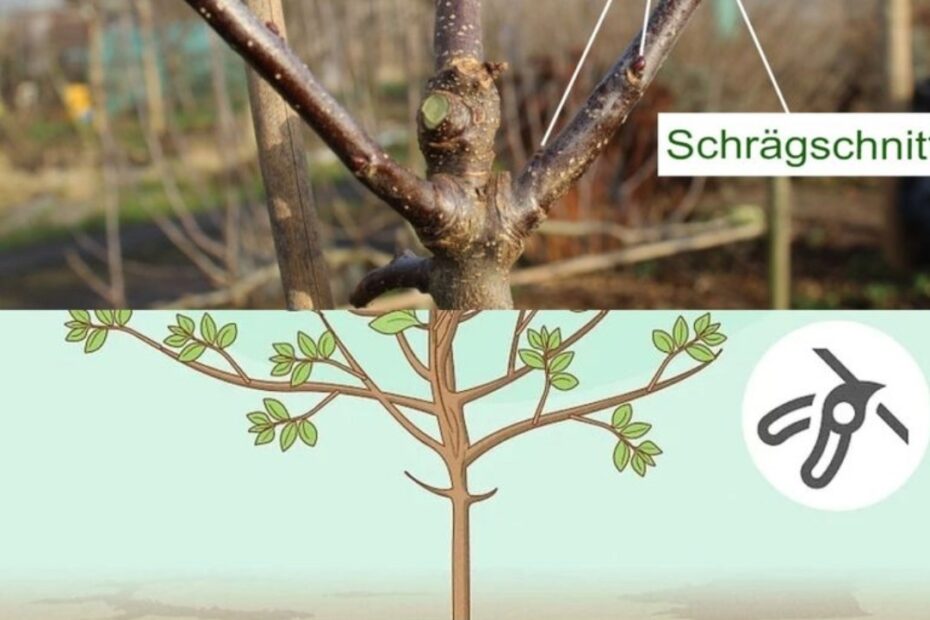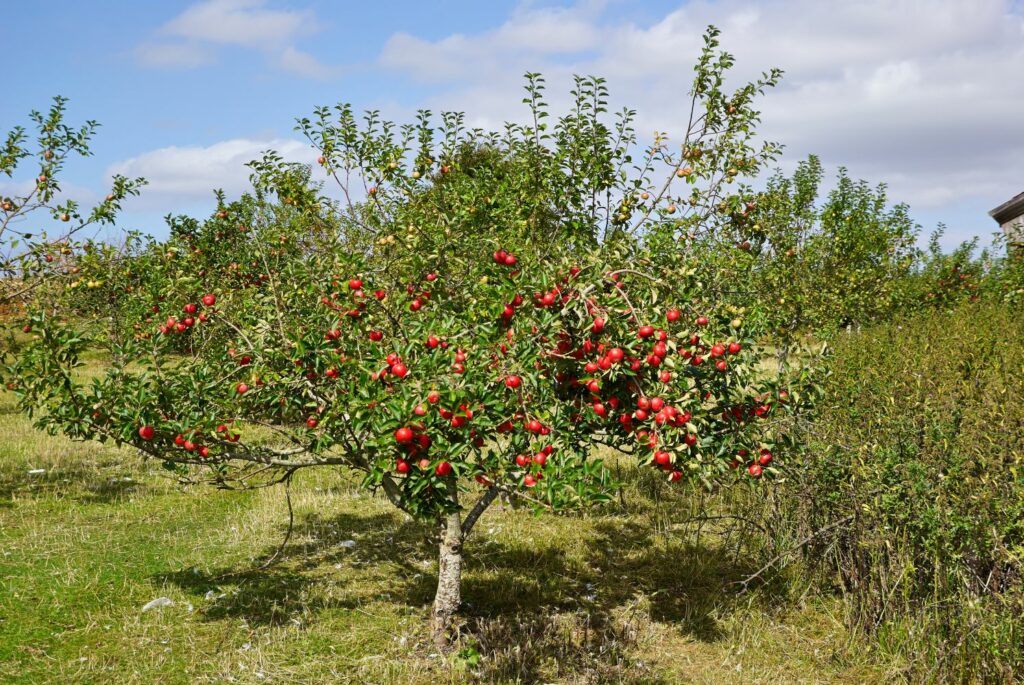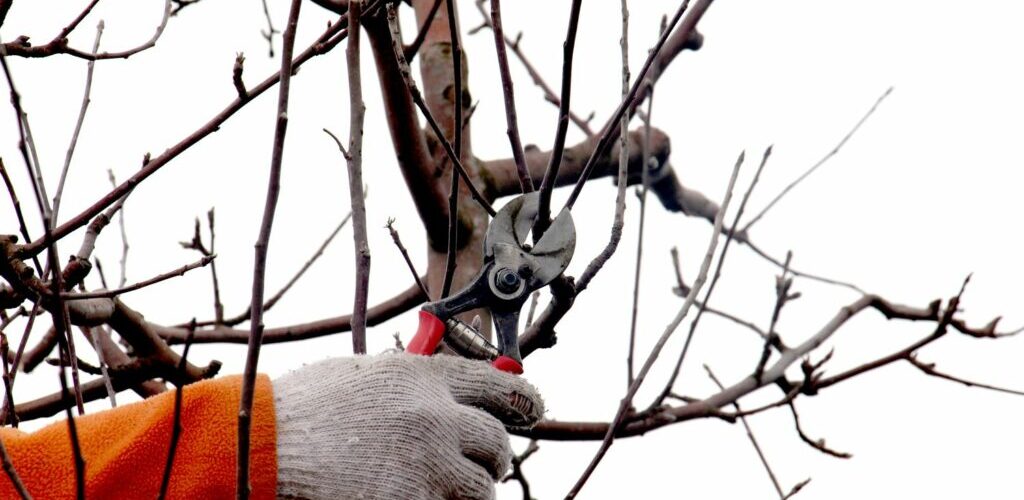
When pruning apple trees, it is important to proceed carefully. With the help of our complete guide to pruning apple trees, you can cut the right shoots at the right time.
To ensure optimal supply to the tree and the most balanced harvest possible every year, it is important to prune an apple tree.
Why should you prune apple trees?
If you observe the growth of the apple tree ( Malus ), you can clearly see that it forms different types of shoots and branches: There are the long, richly leafy, “vegetative” shoots, which hardly bear any fruit. And the short, “generative”, sometimes twisted and very old fruit shoots, which produce flowers and fruit several years in a row. Both types of shoots are important, because we humans want fruit-bearing, generative shoots for our apple harvest. But it is primarily the vegetative, leafy shoots that effectively photosynthesize and nourish the tree – ultimately, they also make the fruit large and tasty. Balancing the growth of vegetative and generative shoots is the most important goal when pruning the apple tree. Diseased branches are also removed to prevent secondary infections and to thin out the crown. This makes harvesting easier and also prevents disease. In addition, old fruit wood is removed and new fruit wood is created – because younger fruit wood produces more beautiful fruit.

Note: There are always discussions about whether apple trees need to be pruned at all. Apple trees are plants that have been greatly modified by breeding and, although they can survive without human care, they are often affected by disease, small fruit and stunted growth.

Pruning an apple tree: The right time
When can you prune apple trees? Many hobby gardeners know that apple trees are pruned in winter, between December and March. In addition, summer pruning can be done on apple trees, but this has a different purpose. You will find out exactly what this means below.
Pruning apple trees in summer
Summer pruning of apple trees is almost never done in home gardens because it is more about optimizing the harvest and therefore comes from professional cultivation. Anyone who does not have to live off their apple trees will hardly reach for the scissors in summer. Pruning the apple tree in summer ensures better light exposure of the fruit, which in turn results in better coloring and slightly improved storage life. It can also “calm down” fast-growing trees by limiting their energy source. For the sake of completeness, however, here are a short instructions for summer pruning of apple trees:
- Only late summer pruning, which takes place while the apples are ripening, is profitable for the home garden. The fruits should already be almost fully developed and are just waiting to take on their beautiful color. It is important that the so-called St. John’s growth has already been completed by this time. This means that the months of July to September are the time window for summer pruning.
- Caution: Pruning too early in summer can lead to underdeveloped fruits.
- Remove or shorten individual shoots that shade fruit hanging on the tree. Do not cut off too many leafy branches, otherwise the apples may be less sweet.
- During summer pruning, old branches that no longer bear fruit of high quality may also be completely removed.

Tip: Some apple tree varieties grow very strongly, while others are more quiet. Summer pruning is only necessary for varieties that grow strongly vegetatively. Trees that produce little vegetative growth anyway should not be deprived of their few leafy branches in summer.
Pruning apple trees in winter
The most important time to prune an apple tree is winter. When pruning in winter from December to March, you have a good idea of which branches should be removed, thanks to the lack of foliage. Pruning in winter is used to build up, maintain or renew the crown.
By choosing the right time within the time frame mentioned above, you can influence the apple tree’s reaction to pruning. Early winter pruning ensures strong new growth, while late winter pruning ensures a weaker reaction.
We explain the different procedures below so that you have everything ready when pruning an apple tree in winter.

Expert tip: Winter frost is not a major argument against winter pruning. As a rule, frost damage does not occur at temperatures down to -5 °C.
Pruning an apple tree: instructions
Now we know when and why it is best to prune the apple tree. But how do you go about pruning the tree? Here we will explain everything you need to know about pruning apple trees in winter.
Note : A mistake that many hobby gardeners make again and again is the following – they try to cut the height of a large apple tree and thus make it smaller. Unfortunately, the growth rate depends primarily on the variety and the rootstock. Cutting vigorously growing trees heavily leads to a strong reaction, i.e. to even more growth. So cut counterintuitively: cut vigorously growing trees as little as possible, and weaker growing trees more.
Recognizing and assessing fruit wood
Apple trees are usually kept in the garden because of their fruit. These are formed on the so-called fruit wood. These are short shoots that sit on the sides of longer shoots and produce both flowers and some leaves. Fruit wood flowers and bears fruit for several years in a row and grows a few centimeters longer each time. Old fruit wood is twisted and particularly easy to recognize. However, it only produces small fruits. Young fruit wood develops on the sides of shoots that have been around for several years and produces larger, healthier fruits. The aim of pruning is also to ensure new, young fruit wood and to remove old fruit wood.

Pruning apple trees in winter: the most important things in brief
1. Choosing the right tool
Using the wrong tool when pruning can do more harm than good to the tree. In any case, the cutting tool should be sharp and the cutting surface should be as straight as possible. Depending on the thickness of the branch, garden shears, branch saws, telescopic shears and telescopic saws are generally suitable for gentle pruning of apple trees. Branch shears are not required as they cannot be guided with sufficient precision. Motorized saws should be avoided if possible as they leave frayed cutting surfaces that are more difficult for the tree to grow over. Also get a sharp garden knife or a hoe, which you can use to carefully smooth the edges of large cutting surfaces.
In general , it is better to work with hand tools and a ladder than with telescopic tools. This is because the cuts made by long tools are always inaccurate and thus increase the risk of undesirable effects such as disease infestation or the increased growth of water shoots.

2. 3 pruning rules for apple tree pruning
- The most important rule when pruning apple trees is that branches are usually cut “at the astring”. A slight thickening is visible at the base of each branch. A branch is removed directly above this. If too much stump is left, numerous side shoots will appear here in the spring, which have to be laboriously removed again. If the branch is cut too low, the tree will have difficulty overgrowing the wound and the risk of fungal disease increases. Of course, there are exceptions to the rule, which we will mention below.

- It is equally important that the shoots of apple trees are generally not “cut”. This means that neither young nor old branches can be cut off anywhere along their length. Instead, a branch is either completely removed or “diverted”. This means that a branch is always cut off directly above the exit of a side branch. In this way – to put it simply – the tree’s energy is redirected to the desired branch. If an apple tree is “cut”, on the other hand, numerous side buds sprout uncontrollably below the cut – most of which are then difficult to remove again. So definitely avoid cutting the tips of your apple tree. There are of course exceptions to this rule.

- The higher and more vertically a branch grows, the stronger it will grow in the future. If an apple tree has one or more desired tips, it is important to maintain their dominance in order to prevent the uncontrolled sprouting of many side buds and to guide the tree towards more moderate growth overall. Make sure that the tips of your apple tree are always at the highest point of the branches. All side branches should be cut lower.

3. Branches that should definitely be removed
- First, look for dead or diseased branches – these must be removed in any case. Torn, hollow or canker-affected branches are cut off.
- Most branches growing into the interior of the tree crown are also removed. You can leave a few shoots that are well decorated with fruit wood. However, strong branches that grow inwards should definitely be removed early before they cause large wounds.

Planting pruning on the apple tree
- Important to balance the relationship between significantly reduced root system (due to digging out) and emerging crown.
- Goal: Construction of the desired crown shape, e.g. funnel crown or pyramid crown.
- Depending on the quality of the young apple tree, there may still be few branches. In order to have more shoots available for the crown structure, the tips of the existing branches are cut, i.e. simply pointed at the top. If shoots are too close together, crossing each other or competing for the same space, some are removed completely.

Training pruning of young apple trees
- For apple trees up to about 10 years.
- Strong-growing trees are only pruned shortly before they sprout, while weak-growing apple trees are pruned in winter.
- Determine the leading shoot(s) : An apple tree with a central axis needs a tip. This ensures that side branches do not grow too strongly vegetatively. The leading shoot should never be cut, but it should be diverted. Funnel crowns or other crown shapes may have several leading shoots.
- Identify side branches ( leading branches ) that remain permanently in the crown and remove competitors early. Leading branches should branch off from the trunk at a fairly flat angle, but not completely horizontally.
- Cut out shoots and branches that point steeply upwards or downwards and are not the leading shoot but compete with it.
- Remove shoots growing inwards after 2 years at the latest – in the meantime, some fruit may still be harvested from them.
- Prune poorly branched shoots if more branching is desired.
- If necessary, shorten leading branches and divert them to suitable side shoots.

Maintenance pruning of adult apple trees
- For apple trees from about 10 years of age.
- Strong-growing trees are only pruned shortly before they sprout, while weak-growing apple trees are pruned in winter.
- If necessary, divert the leading shoot to shoots with a medium growth rate – this will slow down growth minimally.
- Divert leading branches to younger side branches with younger fruit wood.
- Cut out dead, damaged and diseased branches.
- Always remove branches that grow steeply upwards and are not leading shoots.
- Inward-growing shoots should usually be removed – they can be left inside for up to 2 years for harvesting apples.
- Old branches that do not produce any leaves or produce a lot of fruit can be removed in favor of younger branches. Old branches can also be removed during summer pruning if they are particularly easy to recognize by their small fruits and lack of new growth.

Radically pruning an apple tree: rejuvenation pruning
- Rejuvenation pruning is done on trees that hardly produce any new shoots and bear lots of small apples – the aim is to produce new fruit wood. To do this, you may have to cut back a very old apple tree completely, leaving only a few branches.
- The right time is winter to provoke the strongest possible reaction.
- Make sure the weather is dry and sunny so that any wounds that develop can be closed dry.
- In the next two years, it is expected that few apples will be produced.
- Now you can prune your apple tree radically and completely remove diseased, damaged wood and particularly dense and old parts without new growth. Large wounds can be covered with wound closure.
- If the old tree has too few new shoots to which to direct the branch, it may be possible to cut it not to the branch ring but to the cone. In doing so, you deliberately leave stumps from which new shoots will hopefully emerge.
- Wait and see how and where the old tree sprouts the following year and then re-grow a suitable crown from the existing shoots.
- You can also cut branches in subsequent years to encourage new branching.

Tip: If the old apple tree has no young shoots at all, or if these would be lost if other branches were removed, it is worth pruning it in stages: Prune it very heavily in the first year and leave just a few branches. If the tree has sprouted again at the base the following year, you can cut the old part of the apple tree back completely. The best way to support such a weak-growing tree is with additional fertilization: Every year in February, a primarily organic, nitrogen-rich fertilizer can be applied. Its effect is delayed and so arrives just in time for the tree to sprout. Alternatively, a special fruit tree fertilizer can be used. You can apply this liquid fertilizer via the water you use to water your tree from March to August.
Identify and remove water shoots on apple trees
So-called water shoots on apple trees are the shoots that grow steeply upwards. They are usually found inside the tree crown. The bark is usually much lighter and the wood softer. The water shoots can be removed each time the tree is cut back. If a tree that has not been pruned for a long time is cut back heavily, many water shoots will form the next time it sprouts. The best way to remove these is with a summer pruning. Always cut water shoots off at the base, otherwise several new water shoots will grow straight from one stump, increasing the amount of pruning work. If they are well positioned on the branch, vertical shoots can also be bent down using weights or strings and thus made usable. This is because branches that grow almost horizontally are much more likely to produce fruit wood and therefore fruit.

The apple variety ‘Merkur’ is still relatively young. However, it is already a worthwhile insider tip for hobby gardeners due to its robustness and good storage capacity. ‘Merkur’ grows moderately and is therefore relatively easy to care for.

